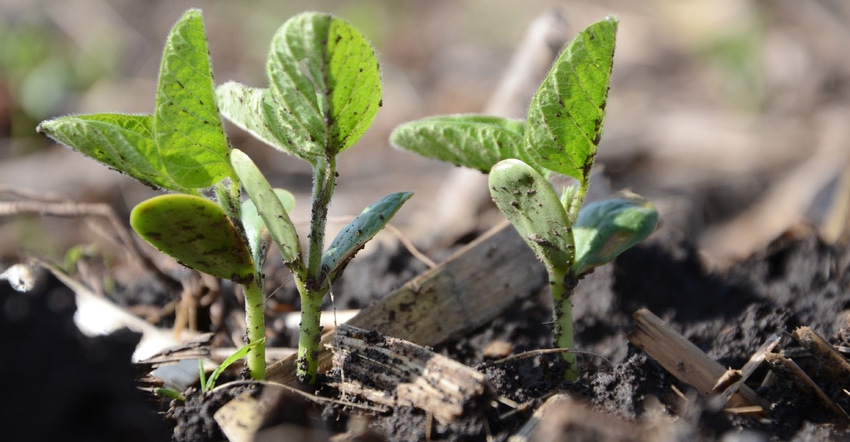November 23, 2020

Building a crop fertility program is an important part of planning in the winter. And for 2021, you may want to consider adding sulfur to your soybean plan. At least that’s what Shaun Casteel, associate professor of agronomy, Purdue University, is suggesting. And he discovered the opportunity almost by accident.
“In 2015, we had 20 inches of rain in June, and I had some sad soybeans in my plots,” Casteel says. “We had uniformly [bad] nodulation — but the plot with ammonium sulfate was one of the 18 treatments, and that boosted yields even in those conditions.”
Since 2016, Casteel has been looking at the use of ammonium sulfate in the soybean fertility program, which provides an element not often associated with this crop — sulfur. “We’ve not really talked about sulfur in soybeans for decades,” he says.
Casteel explains that some fields are more responsive than others, like low-organic-matter, coarse-textured or sandy soils, which do respond well. And he’s seeing a consistent response of soybeans in these sulfur-deficient fields, with yield bumps as high as 13 bushels per acre over plots where sulfur is left off.
Goodbye free sulfur
Most farmers know that since the 1970s, as diesel engines started cleaning up their emissions and fuel suppliers were forced to remove sulfur from their product, it changed the atmosphere and cleaned up the air. The challenge is that the 10 to 15 pounds of free sulfur that most fields were getting (and it could have been more in some areas) has gone away, and Casteel says crops respond to that level of sulfur.
For soybeans, sulfur is used in a number of ways for the basic function of the plant. For example, nitrogen fixation is a key process for soybeans, and S is a cofactor for that. “If you’re short on sulfur, the plant will be short on nitrogen,” Casteel says.
And he’s seeing boosts in a range of conditions, for different reasons. “In fields deficient in sulfur [such as those low in soil organic matter], regardless when we plant, we can see a response from adding sulfur,” he says.
Even if there was a supply of sulfur in the soil, perhaps applied the year before, areas can be situationally deficient, he says. Adding sulfur near planting can make a difference.
For soils high in organic matter, the S may be present but tied up early in the season, when the soybean plant needs it most. “In those soils, the turnover of sulfur and nitrogen is limited due to cool and sometime wet conditions, so sulfur up near planting can allow early uptake by the plant. Having an early sulfur supply jump-starts nodulation and nitrogen fixation, which means having a nitrogen supply. “The addition of sulfur to soybeans should be tested in strips that can be yield-checked, since not every field or situation needs supplemental sulfur.”
Soybeans, yield and protein
Mercedes Gearhart, a longtime agronomist with AdvanSix, one of the world's largest producers of ammonium sulfate, is an advocate of Casteel’s work — after the two met mainly by accident at a trade show. Casteel’s research does link nicely with the AdvanSix product, since he shows the benefit of early sulfur in soybeans. And Gearhart has followed his work for some time.
Casteel’s work does show a benefit to AMS versus granular fertilizers containing half their sulfur in the elemental form. AMS proved to be more efficient, since it took twice the amount of sulfur for the mixed sources to achieve similar yield levels as AMS. “Plant roots can only take up the sulfate form, and only insignificant amounts of granular elemental sulfur convert to sulfate within a season,” Gearhart says. Another area she points out with the benefit of making sulfur available is protein content.
“Usually, when you talk about soybeans, there’s an inverse relationship between yield and protein,” Gearhart says. “When yield goes up, protein levels usually fall. That’s not the case with these treatments. We’re seeing 10- to 12-bushel increases, and protein is increasing as well.”
In sites with lower yield increases — say, 4 to 5 bushels per acre — Gearhart says that protein is still rising 0.3% or 0.4%. For Casteel, that’s an area of further work.
The United Soybean Board, long a proponent of boosting protein levels in soybeans, is sponsoring research in Arkansas, Kansas, South Dakota, Minnesota, Iowa, Illinois and Indiana to further explore that relationship among sulfur, yield and protein levels.
When building your soybean fertility plan for 2021, considering sulfur as an addition may be worth the investment.
About the Author(s)
You May Also Like






